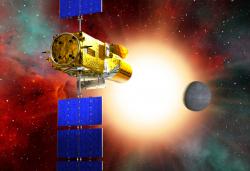 Step aside Hubble, Chandra, Spitzer, there’s a new space telescope ready for launch. On December 27, 2006, the European Space Agency is planning to launch its planet hunting, starquake finding COROT satellite.
Step aside Hubble, Chandra, Spitzer, there’s a new space telescope ready for launch. On December 27, 2006, the European Space Agency is planning to launch its planet hunting, starquake finding COROT satellite.
COROT stands for “Convection Rotation and planetary Transits”. The first part of the name, convection rotation, means that COROT will be able to probe the insides of stars, measuring accoustical waves that ripple across their surfaces. This is a technique that astronomers use called asteroseismology. The second part of the name, planetary transits, refers to its ability to measure how much a star dims when a planet passes in front.
It’s this second ability, planet hunting, that should prove really exciting. COROT will monitor hundreds of thousands of stars at the same time, watching to see if any periodically dim and brighten. Most of the planets COROT will turn up will probably be the “hot jupiters”; large planets circling close to their parent stars. But its instruments should be sensitive enough to find rocky planets that orbit within 50 days of their stars. It could turn up a whole new class of planets never before discovered.
